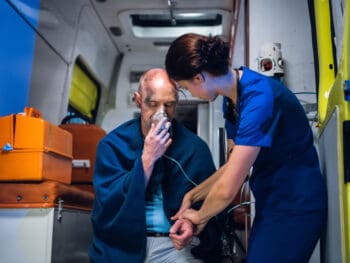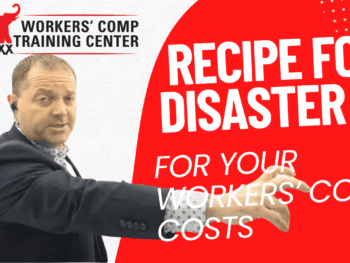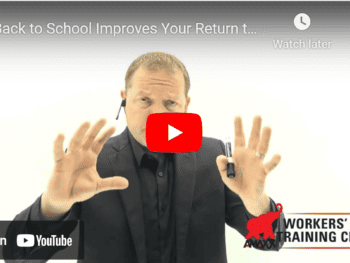
While you may not be able to change all the factors that influence outcomes, you can vastly help improve them. Understanding how certain issues affect recoveries and emphasizing best practices can get your injured workers back on the job faster and save your company money.
Education, Fear of Being Fired, Language
According to WCRI research studies, workers with less than a high school education had poorer return-to-work rates than high school graduates, and the gap was more pronounced compared to those with secondary degrees. Injured workers concerned about being fired had worse outcomes and were more likely to hire attorneys than those without such concerns. Injured workers whose main language was not English were also more likely to have poorer outcomes than those whose primary language was English.
The latest research also shows a correlation between outcomes and the employer’s response to the worker’s initial report of injury. The following were associated with poor outcomes:
- Not being supportive.
- Blaming the worker for his injury.
- Expressing anger toward the injured employee.
- Not believing the person was injured.
- Telling the injured worker not to file a workers’ compensation claim.
When more than one of these responses was present the duration of days out of work was 2 times more than for workers who did not get a negative response.
Click Link to Access Free PDF Download
“9-Element Blueprint To Create Your Workers’ Comp Employee Brochure”
6 Steps to Improve Outcomes
A lower education level, shorter time on the job, and difficulty understanding English all play a part in an injured worker’s concerns about being fired. That particular fear is a strong indicator of when and how well an injured worker will recover.
To combat that concern, employers need to adopt many of the practices associated with an advocacy-based claims model. Simply put, it means treating the injured worker as you would treat a customer. In some cases that might mean changing the culture of an organization, while in other companies it may involve just tweaking and ensuring certain practices are followed. Building trust with the injured worker is key.
Here are steps to help:
- Early contact. Both the supervisor and claims handler should communicate with the injured worker as soon after the injury as possible. Multiple studies show the benefits of this to both the injured worker and the employer. Average claim costs, claim duration, and medical costs are significantly lower when efforts are made to reach out to the injured worker early. The contact should take into consideration the injured worker’s preference; older workers may appreciate a phone call and/or letter, while younger employees may prefer text messaging. Those whose primary language is not English should be contacted by someone who understands and speaks his native tongue. The message should be positive and show concern and caring. The employer should express genuine interest in the employee’s well-being.
- Constant communication. Injured workers often feel isolated the longer they are away from the workplace. By maintaining regular contact, the employer can help ensure the claim is progressing, answer any questions, and keep the injured worker up to date on the latest workplace happenings. Injured workers need to feel they are still part of the organization and should know the employer looks forward to his return. If nothing else, the social interaction itself can help make the injured worker feel less isolated.
- Assign specific contacts. Where possible, a nurse or other medical person should interact with the injured worker to discuss any medical issues. A nurse or claims handler should stay in touch with the injured worker to discuss various aspects of the claims process, including return to work.
- Early access to medical care. Getting medical care to the injured worker as soon as possible not only helps speed his physical recovery, but can also help alleviate his frustrations. It lets him see the process is focused and moving along, rather than being stuck in bureaucracy. Many larger companies have clinics at the work site. Those that don’t may be able to take advantage of companies that send medical providers, such as physical therapists to the work site. Telemedicine is another option companies are increasingly looking to help their injured workers.
- Coordinate care. Injured workers who have risk factors such as lower educational levels, short-term tenure with the employer, or poor English skills should be targeted for coordinated interventions. The employer, claims handler, and any others involved should hold discussions with the injured worker to ensure they are all on the same page and kept up to date.
- Beyond the denied claim. A claim denial should not be the end of the communication, as that can result in litigation. Instead, someone should discuss the reasons for the denial with the injured worker. Also, the injured worker should be told about other options, such as general healthcare. A nurse or someone with an understanding of the claim process and the healthcare system should contact the injured worker to discuss his options.
Summary
There are myriad reasons why workers’ compensation claims deteriorate and have poor outcomes. Research is increasingly uncovering many of them. One thing for certain is that injured workers who feel valued and supported and who understand and engage in the process are more likely to recover quicker and get back to work sooner. The system does not need to be adversarial. Employers willing to treat injured workers with respect and support will create a trusting atmosphere and lower workers’ compensation costs.

Contact: mstack@reduceyourworkerscomp.com.
Workers’ Comp Roundup Blog: http://blog.reduceyourworkerscomp.com/
©2024 Amaxx LLC. All rights reserved under International Copyright Law.
Do not use this information without independent verification. All state laws vary. You should consult with your insurance broker, attorney, or qualified professional.
















